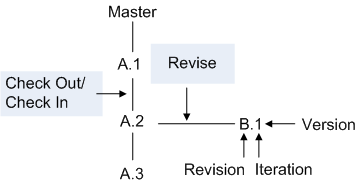Administering the Versioning of Parts, Documents, and CAD Documents
Versioning schemes define the labels, or identifiers, that are automatically applied as object versions are created in a Windchill solution.
Understanding the Use of Versioning Schemes
The following diagram and the sections that follow provide some context on how versioning schemes are used:
Master
When users create a document or part, your Windchill solution creates a master as well as an initial version, which is identified in the previous diagram as revision A, iteration 1 (A.1). The master consists of common attributes for all versions, such as part number or document name.
Version
Version
Revision
When users select the New Revision action, your Windchill solution creates a new version as the start of a new revision of the part or document. For example, if the previous version was A.2, the new revised version would be B.1.
Iteration
When users select the Check Out action, modify the part or document, and select the Check In action, your Windchill solution creates a new version of the part or document as the next iteration of the current revision upon check in. For example, if the previous version was A.2, the new iteration would be version A.3.
Initial Versioning Rules
For all Windchill solutions, load files set the initial versioning rules for parts, documents, and CAD documents in the site context. These rules affect the parts, documents, and CAD documents created from within a product or library.
The default versioning scheme used is set when site context rules are established unless you choose to set them in an organization, product, or library context. The out-of-the-box demonstration template named Product Design sets versioning for a product context. For details on the Product Design template, see
Out-of-the-box Product and Library Context Templates.
| PTC recommends that you establish one versioning scheme for all of your contexts and that you set the versioning scheme in the site context. However, you can override the default versioning scheme for a specific organization, product, or library context. |
Documents, CAD documents, and parts that are created from within a project or program context are not versioned objects.
Preferences for Revision Labels
The Revise category in the Preference Management utility has the following preferences for changing the user interface to allow users to select the revision label:
• Allow Override On Revise -- when set to
Yes, activates the set revision icon

on the
New Revision window. This allows users to select the next revision label from a drop-down list or enter a valid revision label.
• Allow Override On Insert -- when set to Yes, allows users to select the revision label from a drop-down list or enter a valid revision label when inserting an object.
• Allow Override On Create CAD Document -- when set to Yes, allows users to select the initial revision label from a drop-down list or enter a valid revision label when creating a CAD document.
By default, these preferences are set to No.
Additionally, if you are using file-based or state-based versioning scheme, you can define alternate revision labels for revisions. For more information, see
Changing Versioning Schemes.
Changing Versioning Schemes
To change an out-of-the-box versioning scheme, you can change to a scheme that is defined for you or you can define your own scheme. You specify the versioning scheme in an object initialization rule for a particular object type, such as wt.doc.WTDocument. You can view the rules that are being used for versioning from the Object Initialization Rules table using the Object Initialization Rules Administration utility.
Object initialization rules can be set in context templates or by using the Object Initialization Rules Administration utility from within a specific context.
For more information about changing a versioning scheme, see
Changing Versioning Schemes.
For more information about creating context templates, see
Context Templates.
For more information about accessing the
Object Initialization Rules Administration utility, see
Object Initialization Rules.

